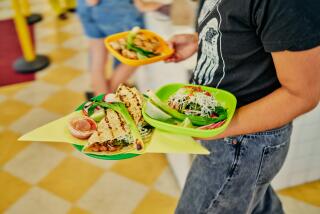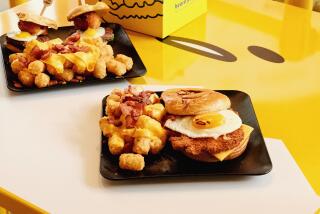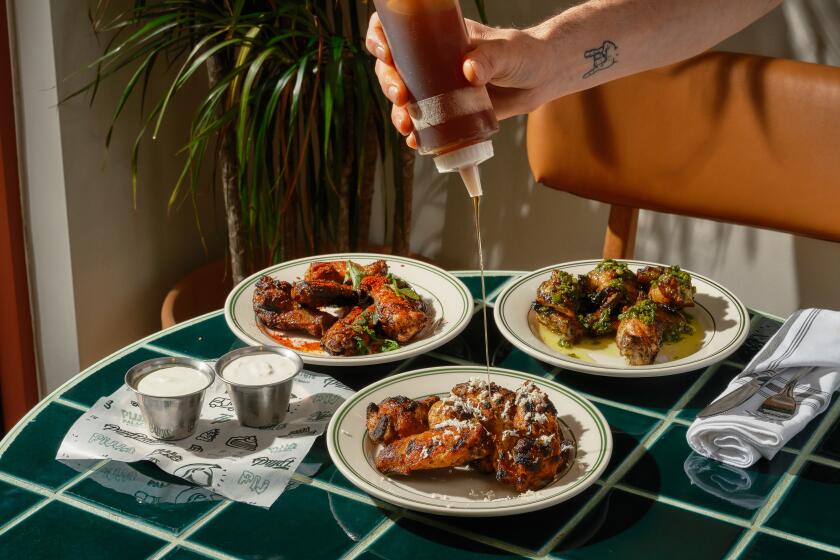Spaghetti takes a wild ride
SPAGHETTI and meatballs isn’t just good comfort food, it’s the kind of food that you crave with a beautiful desperation, that you secretly prefer to those precious items on chic tasting menus, that you’d want for your last meal. Be honest. You’re trapped on one of those imaginary desert islands that doesn’t have restaurants or takeout: What would you want to eat?
Some kind of magic happens when a plate of spaghetti is napped with red sauce and crowned with a few glorious meatballs. It’s a magic that works even on average plates in forgettable eateries, with the most rudimentary of ingredients, at anyone’s table and even if your grandmother was from a Methodist household in Massachusetts, as mine was, instead of the Old Country.
But if ordinary spaghetti and meatballs can suffuse your gastronomic dreams, imagine what would happen with the extraordinary. A plate of perfectly cooked pasta, a beautifully attuned tomato sauce and, instead of the familiar beef or pork meatball, how about one made with duck confit? You might just stay on that desert island.
Ontologically, at least in my book, spaghetti and meatballs require tomato sauce. Rigatoni and pesto, even topped with a terrific meatball, belongs in a totally different category. But who says you need to use meat for the meatball?
A combination of duck breast and duck confit makes fabulous “meatballs,” as does monkfish, even rabbit. Sure, you can make great meatballs with pork, beef, veal or even lamb, but top the pasta and sauce with an “un-meatball” and the dish reaches an entirely new level -- without losing its basic nature.
Jazzing up the old formula shouldn’t affront purists; the dish is a modern invention anyway, constructed in Italian-American kitchens. And when those kitchens are run by creative chefs, the comfort food can take a whole new trajectory. At A Voce, on Madison Avenue in New York, chef Andrew Carmellini laces his signature duck meatballs with foie gras. He serves them as an appetizer, atop potato puree and sour cherry sauce instead of spaghetti, but it’s a dish that’s so popular he hasn’t taken it off the menu in a year. Esca’s David Pasternack goes more traditional, topping the spaghetti and tomato sauce at his New York seafood restaurant with meatballs made with tuna and pancetta.
You get the essence of the dish, but with a new flavor profile that can entirely refresh your favorite comfort food. And when the meatball has been re-envisioned, the sauce can also get a new twist -- just build the flavors and components of the tomato sauce to match the meatball.
Playing with fowl
PAIR rich duck meatballs with a sauce befitting their rustic extravagance. Lace the tomato sauce with the mellow earthiness of porcini mushrooms and a generous pour of red wine, then cook it longer, letting the flavors and textures of the sauce build and deepen. Duck doesn’t want a light sauce, but one with a long trajectory, a lower register, a soothing complexity.
Rabbit meatballs call for a bright spectrum, even a touch of the garden. Thyme, rosemary, parsley and sage go into a tomato sauce, along with white wine, leeks and shallots. Keep the flavors vibrant by just cooking it for a short time, then puree the sauce and stir in finely diced carrots. The sauce is vibrant in flavor and color but delicate and suited to the subtle flavors of the rabbit.
You can take Pasternack’s lead and use fish, but instead of tuna, which is prone to drying out, use monkfish. Monkfish has a fantastic taste -- substantial and full-bodied, even meaty -- and a texture to match. It’s ideal for the meatball treatment. And though these meatballs brown up beautifully, we braise them in the tomato sauce instead; they cook up quickly and are incredibly tender.
Monkfish matches well with olives and capers, so throw a generous handful of kalamatas into a simple tomato sauce and then toss capers into the sauce and the meatballs themselves. A sprinkle of crushed red pepper gives dimension and a bite without obscuring the subtlety of the fish.
None of these “un-meatballs” strays from the basic meatball technique. Some bread crumbs, an egg, chopped parsley and salt and pepper is all you need to add to a bowlful of ground duck or monkfish, the same as it is for beef or pork. Use bread crumbs that first have been softened (in either milk or water), then squeezed of excess liquid for the right texture.
Don’t add grated Parmesan or chopped garlic as your grandmother might have added to her veal meatballs; they can overwhelm the more delicate flavors. Instead throw in more fresh herbs.
While the herbs, salt and pepper flavor the meatballs, the softened bread crumbs and egg bind the ingredients together. You want a balance to the mixture: some moisture, enough fat, a little structure, not too much weight. Meatballs are surprisingly delicate; there’s a reason, after all, why most of us don’t dream about meatloaf.
A beautiful braise
ANY kind of meatball can be braised instead of browned. It eliminates a step and it’s good for more delicate flavors such as the monkfish. Before browning or braising the batch, fry up a single meatball as a tester. Even if you’re confident in a recipe, it’s good to taste for seasoning.
Then you can let your imagination go a little wild. Try making little tiny meatballs, scattering them down your mountain of sauced spaghetti. Or scale them so each person has one giant meatball, coconut-sized maybe -- it’s your desert island, after all.
Whether browned or braised, dainty or gargantuan, the meatballs are placed in their sauce for the last half-hour of cooking. Put the cover on the pan, turn the heat to low and enjoy the happy aroma.
And because a good plate of spaghetti and meatballs requires a glorious tangle of perfectly cooked pasta, bring a big pot of salted water to a boil while you’re waiting.
Good spaghetti has a nutty flavor and a distinct mouth-feel to it, a bite and flavor that can stand up to the weight of the sauce and the meatballs that top it. Fresh pasta is too tender, so choose a high-quality dried spaghetti. Take it to just this side of al dente, because pasta cooks a little after you lift it out of the water (especially since you don’t want to rinse it).
Then it’s just a matter of building the plate -- a swirl of spaghetti, a ladleful of sauce, a single meatball or a dozen of them. Twirl your fork, and ignore the passing ships.
--
--
(BEGIN TEXT OF INFOBOX)
Spaghetti and rabbit meatballs
Total time: 2 hours
Servings: 6 as a main course
Note: Rabbit is available from Bristol Farms, Gelson’s, Puritan Poultry at the Original Farmers Market, select Jons markets and Bob’s Market in Santa Monica. (Puritan, Gelson’s and Bob’s Market will de-bone the rabbit if you call ahead.)
1 cup coarse country-style bread crumbs
1 (12-ounce) package uncured bacon, cut lengthwise into 1/2-inch pieces, divided
1 rabbit
1 egg
1 teaspoon kosher salt, divided
3/4 teaspoon white pepper, divided
6 tablespoons fresh parsley, finely chopped, divided
3 tablespoons fresh sage, finely chopped, divided
Flour for dredging
1 cup finely chopped onion
1 cup chopped leeks (white part only)
1 clove garlic, minced (about 1 1/2 teaspoons)
1 tablespoon minced shallot
3/4 cup dry white wine
1 (28-ounce) can diced San Marzano or other plum tomatoes
2 tablespoons finely chopped fresh rosemary
2 sprigs fresh thyme
1/4 cup finely diced carrots
1 pound spaghetti
1. Cover the bread crumbs with water and set aside to soak.
2. Meanwhile, in a large skillet over medium-high heat, cook half the bacon until crispy. Remove the bacon with a slotted spoon and set aside. Pour off the bacon fat and reserve each in a separate bowl.
3. Cut up the rabbit: First, separate the legs and loins from the body. Cut all the meat from the bone and cut away any silverskin and fat. Coarsely chop the meat: You should have about three-fourths pound. Place the meat into a food processor and pulse several times until it is coarsely ground, being careful not to over-process. Transfer to a large mixing bowl.
4. Squeeze the water from the bread crumbs and add them to the rabbit meat, along with the egg, one-half teaspoon salt, one-half teaspoon white pepper, 1 tablespoon parsley and 1 tablespoon sage.
5. Pulse the remaining bacon briefly in the food processor, then add it to the bowl. Mix the ingredients thoroughly with your hands and then form the mixture into balls, using about 1 tablespoon for each meatball. Dredge the meatballs lightly with flour and set on a tray or baking sheet. This makes about 30 meatballs.
6. In a large skillet, heat 2 tablespoons of the bacon fat over medium-high heat until the fat is hot and a few drops of water spit when sprinkled in. Brown the meatballs in two batches, turning with kitchen tongs so they brown evenly, about 2 to 3 minutes. (They will be brown but not cooked through.) Set aside on a tray or baking sheet covered with a paper towel.
7. Wipe out the pan and add 2 tablespoons bacon fat over medium-high heat. Add the onions and leeks, turn down the heat to low and saute until soft, about 4 minutes. Add the garlic and shallots and cook an additional 2 minutes. Deglaze with wine, then add the can of tomatoes plus the juice, rosemary, the remaining 2 tablespoons of sage, one-half teaspoon salt, one-fourth teaspoon white pepper, and the thyme sprigs. Bring to a simmer, then cover and reduce the heat to low. Cook for 30 minutes, checking and stirring the sauce occasionally.
8. After 30 minutes, remove the pan from the heat and puree the sauce in a blender. Return the sauce to the pan, add the meatballs and the carrots and cover to coat. Cover the pan and simmer another 30 minutes, stirring occasionally.
9. Meanwhile, in a large pot, bring 6 quarts of water and 2 tablespoons salt to a boil. After the meatballs have simmered 30 minutes, take the pan off the heat and cook the pasta. Cook the pasta to al dente, according to the package instructions, and drain. Serve the meatballs and sauce over the spaghetti, garnishing the plates with the cooked bacon and the remaining chopped parsley.
Each serving: 651 calories; 34 grams protein; 90 grams carbohydrates; 4 grams fiber; 14 grams fat; 4 grams saturated fat; 88 mg. cholesterol; 1,164 mg. sodium.
--
Spaghetti and monkfish meatballs
Total time: 2 hours
Servings: 6 as a main course
1 cup coarse country-style bread crumbs
1 1/2 pounds monkfish fillets
1 egg
1/4 cup finely chopped fresh parsley
1/8 cup drained and chopped capers, plus 1 tablespoon whole capers (drained), divided
2 tablespoons plus 1 1/2 teaspoons kosher salt, divided
1/4 teaspoon freshly ground black pepper
1/4 cup olive oil
1 medium onion, finely chopped (about 2 cups)
2 cloves garlic, minced (about 2 tablespoons)
1 (28-ounce) can diced San Marzano or other plum tomatoes
2 tablespoons thinly sliced basil
1 cup pitted kalamata olives
1/4 teaspoon red pepper flakes
1 pound spaghetti
1. Place the bread crumbs in a small bowl and cover with water to soak.
2. Remove any membrane from the monkfish and discard. Chop the monkfish into small pieces and place in a food processor; pulse a few times until the fish is coarsely ground, being careful not to over-process. Transfer to a large mixing bowl.
2. Squeeze the water from the breadcrumbs and add the breadcrumbs to the fish, along with the egg, parsley, the one-eighth cup chopped capers, 1 teaspoon salt and the black pepper. Mix the ingredients thoroughly with your hands and then form the mixture into balls, using about one-eighth cup for each meatball. Set on a tray, cover with plastic wrap and refrigerate. This makes about 30 meatballs.
3. Add the olive oil and the onions to a large saute pan over medium heat. Cook the onions until soft (turning the heat to low if they begin to brown), 5 to 7 minutes. Add the garlic and cook an additional 2 minutes. Add the can of tomatoes plus the juice, basil, one-half teaspoon salt, the olives, 1 tablespoon whole capers and the red pepper flakes. Bring to a simmer over high heat, then reduce to low, cover and cook for 30 minutes. Check the pan occasionally, stirring once or twice to make sure the sauce isn’t sticking to the bottom of the pan.
4. After 30 minutes, add the meatballs to the sauce, arranging them on top of the sauce. Cover and continue to simmer for 30 more minutes.
5. Meanwhile, bring 6 quarts of water and the remaining 2 tablespoons of salt to a boil in a large pot. When the meatballs have cooked 30 minutes, take the pan off the heat and cook the pasta, and drain. Serve the meatballs and sauce over the spaghetti.
Each serving: 589 calories; 31 grams protein; 79 grams carbohydrates; 4 grams fiber; 16 grams fat; 3 grams saturated fat; 64 mg. cholesterol; 1,135 mg. sodium.
--
Spaghetti and duck meatballs
Total time: 2 1/2 hours
Servings: 6 as a main course
Note: Duck breasts are available at Bristol Farms, Whole Foods and Surfas in Culver City; duck confit and duck fat are available at select Whole Foods, Surfas and Marcel Marceau at the Original Farmers Market.
2 ounces dried porcini mushrooms
1 cup coarse country-style bread crumbs
2 confit duck legs, at room temperature
2 duck breasts
1 egg
1 teaspoon plus 2 tablespoons kosher salt, divided
1/4 teaspoon freshly ground black pepper
1/4 cup fresh parsley, finely chopped
Flour for dredging
5 tablespoons duck fat (can substitute olive oil), divided
1 cup onions, finely chipped
3 tablespoons garlic, minced
1 cup dry red wine
1 (28-ounce) can diced San Marzano or other plum tomatoes
2 bay leaves
1/4 cup tomato paste
1 pound spaghetti
1. Into a medium bowl, pour 1 cup boiling water over the dried mushrooms and set aside to rehydrate. In another small bowl, pour enough water to cover the bread crumbs and allow to stand.
2. Separate the duck confit from the bones and skin and pulse briefly in a food processor until coarsely ground. Remove to a large bowl and set aside. 3. Remove the skin from the duck breasts and coarsely chop the meat with a knife. Pulse the breasts briefly in a food processor, until the mixture resembles ground beef. Do not over-process. Remove the meat from the processor and add to the confit in the large bowl.
4. Squeeze the water from the bread crumbs and add them to the bowl. Add the egg, 1 teaspoon salt, one-fourth teaspoon pepper, and the parsley; mix to combine. Form the mixture into meatballs, a scant one-fourth cup each. Roll the meatballs in the flour, coating them lightly, and place them on a tray or baking sheet. The mixture should yield 12 meatballs. Set aside.
5. In a large skillet, heat 3 tablespoons of duck fat (or olive oil) over medium-high heat until the fat is hot and a few drops of water splatter when sprinkled in. Brown the meatballs in two batches, turning with kitchen tongs so that they brown evenly, 3 to 5 minutes. (They will be brown but not cooked through.) Set aside on a tray or baking sheet, covered with a paper towel.
6. Wipe out the pan and heat 2 tablespoons of duck fat (or olive oil) over medium-high heat. Add the onions, turn down the heat to low and saute until soft, about 4 minutes. Add the garlic and cook an additional 2 minutes. Add the wine, the canned tomatoes plus the juice, the mushrooms and their soaking liquid, the bay leaves and the tomato paste. Bring to a simmer over medium-high heat, then cover and reduce the heat to low. Cook for an hour, checking periodically to make sure the sauce is at a slow simmer and isn’t sticking to the bottom of the pan.
7. After an hour, add the meatballs to the sauce, covering to coat them. Cover and simmer 30 more minutes.
8. Meanwhile, bring 6 quarts of water and 2 tablespoons salt to a boil in a large pot. When the meatballs have simmered 30 minutes, take the pan off the heat and cook the pasta. Cook the pasta al dente, according to the package instructions, and drain. Serve the meatballs and sauce over the spaghetti.
Each serving: 737 calories; 36 grams protein; 95 grams carbohydrates; 8 grams fiber; 20 grams fat; 6 grams saturated fat; 127 mg. cholesterol; 675 mg. sodium.
More to Read
Eat your way across L.A.
Get our weekly Tasting Notes newsletter for reviews, news and more.
You may occasionally receive promotional content from the Los Angeles Times.







